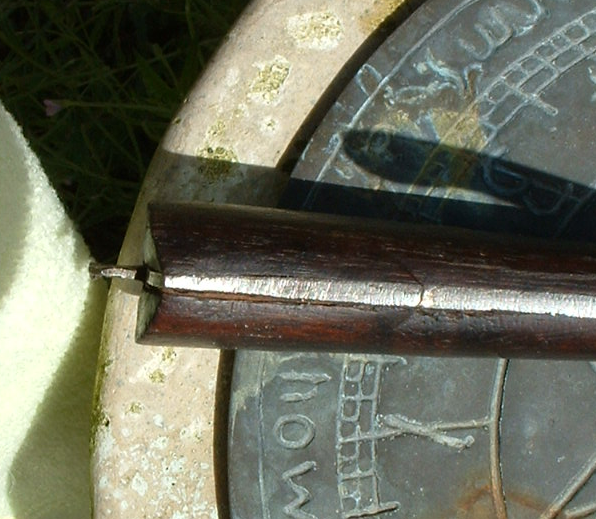
 |
|
|
|
|
#1 |
|
Member
Join Date: Dec 2004
Location: Europe
Posts: 2,718
|
Thanks for the nice words Gene, but you are way too kind, all I did was to look in some of my books and add a few words
 . .I have had a look in the books I have on Persian arms – no Zirah-Bhonk. This is strange, as Stone writes it is Persian, but maybe he was mistaken. I did however find one somewhat similar in ‘Weapons of the Islamic World’, it is a catalogue made for an exhibition at The Islamic Gallery in King Faisal Foundation Centre, Riyadh, 1991, page 97 #96. If the text on the picture can’t be read, here it is. ‘An Indian dagger decorated in Johar flakes. The blade and the hilt are both gilded in Kashmiri style. Indian XIVth century A.H. (19th century AD). |
|
|

|
|
|
#2 |
|
Member
Join Date: Mar 2006
Location: Room 101, Glos. UK
Posts: 4,259
|
hi mare,
here's an overall picture, you can make out the 'C' fairly well.  here's a closeup  (the 'ethnographic' arms at the top of the picture belong to Millie (aka. Balto Millenium), my irish 45mph couch potato) |
|
|

|
|
|
#3 |
|
Member
Join Date: Dec 2004
Location: Europe
Posts: 2,718
|
I have seen the ’C’ (smiley) before, but mostly they are not so far down the hilt, those i have seen are almost as if they are a rest to the little finger, but it can not be so in this case – or the little finger must have been veeery big. Even more so, that it on Gene’s hilt is marked with a colour. It does have a meaning, or they would not have made it, but I have a blank spot I am afraid. I am however looking forward to a picture of the magnetic fields. Gene, I was afraid you had sold your collection of compasses after the last big test
 . .Come to think of it Gene, is there any decoration at the base of the blade? I don’t know how many balls there are supposed to be, but how many are there in your hilt? The shut seems to be rather big, can the balls fall out? Last edited by Jens Nordlunde; 29th July 2007 at 05:41 PM. |
|
|

|
|
|
#4 |
|
Deceased
Join Date: Dec 2004
Location: USA, DEEP SOUTH, GEORGIA, Y'all hear?
Posts: 121
|
Kronckew, great pictures you posted, like you dog also, being a dog nut, what breed is it?.
The "Smiley" on your kard is about the same place as it is on mine. Not in the "pinkie" finger area that Jens has seen before. I have never seen that cut on a hilt before and hope some of the forum folks Could shed some more light on it. Wounder if it is a maker's mark? Jens the dark area inside the "smiley" cleaned off as it was just dirt. Used Ren Wax and it came off. I also did a quick clean on the blade and an acid etch. Found what I think is a temper line on the blade (see pictures), but nothing else, the crucible steel pattern did show up rather nicely though. You can also see a forging crack on the blade. Jens the slot for the balls/tears is rather large but the ball will not come out and there are 12 steel balls in the slot. I, at first counted 13 but did a recount and there are 12, no Jens one did not fall out. Anyone got any idea how the ball were placed in the slots? Last edited by Mare Rosu; 29th July 2007 at 07:37 PM. |
|
|

|
|
|
#5 |
|
Member
Join Date: Mar 2006
Location: Room 101, Glos. UK
Posts: 4,259
|
hi mare,
caution thread veer ahead: Millie is a retired NGC greyhound, she raced up till 2004 and was a grade A1 just before she was injured and stopped racing (she won her next to last race at 10:1 & made her owner a bundle, then hurt her foot next race when another dog collided with her. i adopted her a few months later to be a companion for me and my other (male) greyhound, Blue - a blue brindle)  Blue was found as a stray puppie & i've had him since he was 10Mo. - he's never raced. Both on the spare bed: (both are about 65lb each of pure muscle)  end of thread veer zone: we now return you to our normally scheduled subject. re the balls: i suspect that the channel was cut into the grip, the balls added then the metal cover was set into the grip to retain them. clever craftsmanship could have notched the recess in the ivory such that a slightly sprung hooked area on the retainer clicked into place without need of cement... |
|
|

|
|
|
#6 |
|
Member
Join Date: Apr 2005
Posts: 3,255
|
Hello Gene,
Just as an aside: the magnetic field seems to follow the blades curve - is it possible that the (relatively) low forging temperature of wootz allows an original ingot to remain magnetized? That still wouldn't explain the reversal though! I know that a magnetized steel needle becomes depolarized when heated to glowing red - what about dendritic steel though? Need to pull out my compass and test another recurved blade... Regards, Kai |
|
|

|
|
|
#7 |
|
Member
Join Date: Dec 2004
Location: Europe
Posts: 2,718
|
Nice kard you have Kronckew, and you are right, it is the same type of smiley. Do you have any idea; even a guess would do at this time, of what the meaning can be? I believe the channel in which the balls run must have been made finished before the balls were entered. If the front had been more open in a place, and when the balls were in place had to be hammered back in place, it could easily have happened that the part being hammered at could/would have been hammered a bit too much down, and spoil the running of the balls. To my opinion the place where the balls were entered must be hidden by one of the grip shells.
Well Gene, you surely have a nice collection of compasses as well as weapons, and you are a specialist in finding blades with a multiply of poles  . Do you demand a compass reading before you buy, or do you make the test when you have the weapon? It looks rather confusing, and maybe Kai is onto something, but on the other hand, I thought that iron/steel would loose the magnetism then you hit it. It is some time ago I read this thread http://www.vikingsword.com/vb/showthread.php?t=292 but the answer to the question should be hidden in one of the posts. . Do you demand a compass reading before you buy, or do you make the test when you have the weapon? It looks rather confusing, and maybe Kai is onto something, but on the other hand, I thought that iron/steel would loose the magnetism then you hit it. It is some time ago I read this thread http://www.vikingsword.com/vb/showthread.php?t=292 but the answer to the question should be hidden in one of the posts.
|
|
|

|
|
|
#8 | |
|
Member
Join Date: Jul 2007
Location: Virginia
Posts: 539
|
Quote:
Edgerton has a similar admission in his book on Indian Arms and Armor. rand |
|
|
|

|
|
|
#9 |
|
Member
Join Date: Dec 2004
Location: Europe
Posts: 2,718
|
Rand, does this mean that you think this dagger is likely to come from the NNW, rather than from Persia - I do, but I can't prove it yet.
Yes, there are errors in Stone as well as in Egerton, but they have given us a lot of knowledge as well, and writing books like they did, without errors would be almost impossible, even to day, as many of the 'newer' books also have errors. |
|
|

|
|
|
#10 |
|
Member
Join Date: Jul 2007
Location: Virginia
Posts: 539
|
hey Jens,
I see Indian work written all over this dagger. Look at the wootz, its dense and grey, a flambouyant armor piercing blade, the chisel work on the bird with triangular edges. You will find this type dagger categorized many times as Indian and not so often as Persian. Although I do believe there are Persian exaamples too. The Persian asthetics are more refined and less opulant. This in no way is to take away from this dagger, its a very desirable item. Correct me if I am wrong, but doesn't this dagger have Indian elephant ivory for the grip scales? If it does that would be another indication of Mughal taste. Oh Jen, have found more examples of that chevron design similar to your tulwar on armor, most of it 16th -17th century. There is also some sumptuous Russian armor with the chevron designs. Persia lost Armenia and the Caucasus to Russia in the 19th century so you can see how it becomes harder and harder to say something is from somewhere. Brian...are you reading this? Whats your opinion? The simple designs tend to be early and the Persian work a less is more attitude, where as Mughal work can tend to be more is better. Can be a reflection of the need and desire for individualism. Hope you find a treasure during you travels Jen, rand |
|
|

|
|
|
#11 |
|
Deceased
Join Date: Dec 2004
Location: USA, DEEP SOUTH, GEORGIA, Y'all hear?
Posts: 121
|
Rand, Jens:
More great information coming from you folks  Rand you think it may be Elephant Ivory on the dagger? Can you or Jens or anyone else,tell me what to look for in trying to determine just what kind of Ivory it is. Could it be bone even? I may be able to take a close up of the "wings" if that would help. Gene |
|
|

|
|
|
#12 |
|
Member
Join Date: Dec 2004
Location: Europe
Posts: 2,718
|
Gene, yes I believe the grip scales to be elephant ivory, and not walrus ivory like they mostly used for these knives. One thing which you must remember, if you buy anything of ivory abroad, and that is to ask the seller to get a CITES certificate. If you don’t have such a certificate you can be in deep trouble and risk to get the item confiscated.
Rand, the scales sure look like ivory to me – does not make the dagger ant worse. Maybe we should discuss the zigzag/chevron thing in PM’s or maybe on another thread, not to muddy the waters too much  . .
|
|
|

|
|
|
#13 |
|
Member
Join Date: Jul 2007
Location: Virginia
Posts: 539
|
Indian elephant ivory stays white, fine grained
African elephant ivory turns yellow then brown, fine grained Walrus ivory (shirmani) turns yellow then brown, mottled or granular rand |
|
|

|
 |
|
|